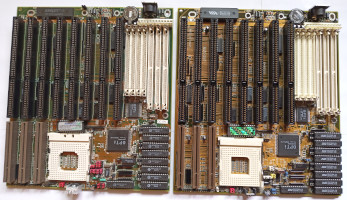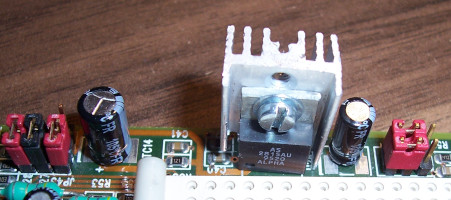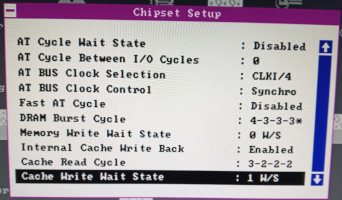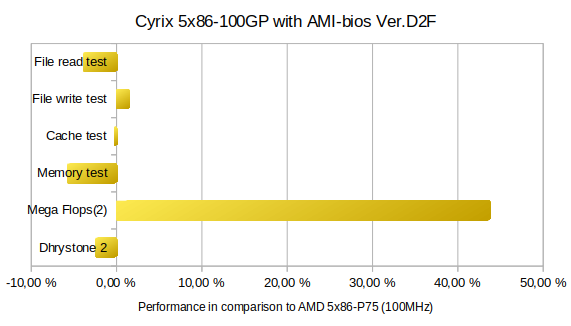
This motherboard exists from two manufacturers: Lucky Star (OPTi895E Ver. D2F on the left side) and EDOM / Win Technology / WinTec (MV035F on the right side of the photo above).
Both boards are so similar that I assume:
- EDOM was "only" a sales organisation in Fremont / California
- A relationship existed between the companies Lucky Star and Win Technology
- Lucky Star was finally the hardware manufacturer
Unfortunately, I can't prove my thesis because you can't find anything about it on the internet today...
If you can add some facts to this topic - news are welcome... :o)
I looked for "MV035" or "OPTi motherboard" on ebay in February 2021 and found the following variants:
| Model name: | Chipset | Date code of the chipset |
| D2C | OPTi 82C895 | week 43 of 1994 |
| D2E | OPTi 82C895 | week 52 of 1994 |
| D2F | OPTi 82C895A | week 24 of 1995 |
| MV035 (without any revision) | OPTi 82C895A | week 17 of 1995 |
| MV035 Rev. F | OPTi 82C895A | week 17 of 1995 |
| MV035F | OPTi 82C802GA | week 43 of 1998 |
The count of mounted parts can be very different from version to version. I saw boards which haven't VESA local bus slots, also no voltage regulator and no cache memory.
But all PCB versions are very, very similar: only small differences in the silk printing or e.g. the position of jumper JP43 and jumper P20.
The motherboard was produced over a long period of time because it was used in the industrial environment.
Performance
The performance was measured during my "chipset race".
AMD 5x86-P75 on LS OPTi895E Ver.D2F
The missing 3.45V voltage regulator and some missing pin-headers avoid the usage of the latest 486DX4 processors. But all is prepared for it we just have to place the parts...
The voltage regulator

I saw on a photo in the web: EDOM used the Alpha / Sipex AS2815AU in the adjustable version for part U28 but other low drop voltage regulators with 1.5A output do the job also (e.g. Texas Instruments LM1086 - the type 1086 is also available from other manufacturers: Analog Devices LT1086 / ST LD1086 / Diodes AP1086...)
The voltage regulator needs the following electrolytic capacitors: TC13 22uF/16V and TC14 at least 150uF / 6.3V (more capacitance leads to a better filtering). I used 330uF / 6.3V for TC14 from Panasonic's FR-series (low ESR types). Both capacitors have a pin spacing of 2.5mm.
Jumper JP43 is part of the voltage regulator on the motherboard version D2F: it must be set to pin 1-2 for 3.45V output voltage.
The jumpers
I copied the settings from the EDOM MV035 revision D which fit well for my Lucky Star D2F board:
| Jumper: | AMD 5x86-P75 | Cyrix 5x86-100GP |
| JP9 | open | open |
| JP10 | close | open |
| JP11 | 1-2 | 2-3 |
| JP12 | 1-2 | open |
| JP13 | 1-2 | 1-2 |
| JP15 | open | close |
| JP19 | 1-2 | 1-2 |
| JP20 | close | open |
| JP21 | close | open |
| JP23 | 1-2, 3-4 | 1-2, 3-4 |
| JP29 | 3-5, 4-6 | 3-5, 4-6 |
| JP30 | 4x multiplication factor: 1-2, 3x multiplication factor: open | open |
| JP32 | open | 2-3 |
The BIOS
The AMI bios of my Lucky Star D2F board shows the AMD 5x86-P75 as AMD 486DX4-120. Is this a disadvantage?
Well, the board of Lucky Star delivered a lower performance at the first test. I compared the BIOS settings of its AMI-BIOS with the settings of the AWARD-BIOS on the MV035F. AWARD uses a faster setting for the RAM and the Cache chips:

I copied this setting to the AMI-BIOS and both boards deliver nearly the same performance:

Also the Cyrix 5x86-100GP is well supported by this board (here in comparison to a 100MHz clocked AMD 5x86-P75):

Facts
| Manufacturer / Type: | Lucky Star OPTi895E (label: Ver.D2F) |
| Year of manufacture: | November 1995 |
| Bios-String: | 40-0100-001256-00101111-072594-OPTI802-U |
| Bios: | Ver.D2F (July 25, 1994) |
| Chipset: | OPTi 82C895A (24/1995) |
| OPTi 82C602A (31/1995) | |
| Manual: | As PDF (source: see 1)) |
1) The images for the PDF file was found on: www.elhvb.com.
| Manufacturer / Type: | Win Technologies Co., Ltd. (Edom) MV035F |
| Year of manufacture: | app. end of 1999 |
| Bios-String: | 11/17/95-OPTI-802G-2C4UKW01-00 |
| Bios: | MV035F (November 17, 1995) |
| Chipset: | OPTi 82C802GA (25/1995) |
| OPTi 82C602A (43/1999) | |
| Manual: | Scan of my manual |
Summary
Strong points:
- Very good performance
- A lot of interfaces: eight 16bit ISA slots, three VESA Local Bus slots
- If all parts are mounted: support of nearly all 486 processors
Weak points:
- It is a little bit tricky to find the right jumper settings because it exists so many versions of this board.
- A lot of parts are not placed on some versions (VLB, cache, 3.45V regulator, pin headers for jumpers). Please check it carefully before you buy this board (depending on your expectations)...
Other stuff
- The BEK-V429S could be identical to MV035 Rev. F.
- This board was also available from Dash Computer Inc.
- The versions C to F are showed on www.elhvb.com
falk.richter*at*yandex.com
Last update: July 15, 2021